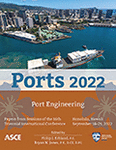PIANC Working Group 211: Reliability Based Design of Marine Fenders—No More Abnormal Berthing Factor
Publication: Ports 2022
ABSTRACT
Design of fender systems consists of two distinct steps: selection of an appropriate fender based on berthing energy demands from the berthing vessel and design of the supporting structure based on the reaction force imposed by the fender on the structure. Both steps include load or safety factors to increase the level of safety. The factor applied to the selection of fenders has up until now been referred to as an “abnormal berthing factor,” with relatively vague recommendations for suggested values for use, usually between 1.25 and 2.0. British Standards (BS 6349-4:2014) has recently chosen to refer to this value as an “energy factor” instead of the previously used abnormal berthing factor. Codes and standards for design of most structures are often based on methods involving what is often referred to as load factors, partial load factors, or resistance factors. As an example, Load and Resistance Factor Design (LRFD) in the US applies load factors to the different loads acting on a structure, and resistance factors to the capacities provided by the structural elements. Similarly, the Eurocode, OCDI, and British Standards use the partial factor method where the effect of the characteristic action, which can be a specified load or imposed deflection, multiplied by the load factor must not exceed the design resistance, i.e., characteristic resistance divided by the partial factors for materials. Although their applications are seemingly simple, these methodologies are based on substantial statistical work, including extensive collection of statistical data, a careful analysis of the data, and appropriate selections of safety levels and acceptable probabilities of failure. This paper explores how utilizing statistical data from berthing velocities, fender manufacturer data, and other adjustment factors were used to establish suggested partial energy factors for selection of fenders. This is what previously has been described as the abnormal berthing factor. By utilizing this method, energy factors can be recommended based on several factors, such as anticipated vessel traffic, type of terminal, type of fender system, or whether the analysis is done for new or existing structures. The suggested factors will provide much clearer guidance than what is currently given in the current fender design guidelines from PIANC WG33 and will be the basis for recommendations on energy factors in the upcoming document from WG211.
Get full access to this article
View all available purchase options and get full access to this chapter.
REFERENCES
ASCE. (2017). Minimum Design Loads and Associated Criteria for Buildings and Other Structures, Standard ASCE/SEI 7-16. ASCE, Reston, VA.
PIANC. (2002). Guidelines for the Design of Fenders Systems,. PIANC, Brussels, Belgium.
Ueda, S., Yamase, S., and Okada, T. (2010). Reliability Design of Fender Systems for Berthing Ship. Proc. Of Intl’l. Navig. Congr. No. 79.
PIANC WG 145. (2020). Berthing velocity analysis of seagoing vessels over 30,000 DWT (2020). Brussels, Belgium: PIANC.
Orlin, F. Reliability-Based Assessment for Fender Systems. Delft, Netherlands, 2020.
Brolsma, J. U., Hirs, J. A., and Langeveld, J. M. (1977). Paper on Fender Design and Berthing Velocities. Leningrad, Russia. PIANC World Congress.
ROM 0.2-90. (1990). Maritime works recommendations: Actions in the design of maritime and harbour works. Madrid, Spain. Puertos del Estado. ISBN 978-8-488-97500-3.
Roubos, A. A., Peters, D. J., Groenewegen, L., and Steenbergen, R. D. J. M. (2018). Partial safety factors for berthing velocity and loads on marine structures. Marines Structures. 58. pp.73–91.
Roubos, A. A., Groenewegen, L., and Peters, D. J. (2017). Berthing velocity of large seagoing vessels in the port of Rotterdam. Marines Structures. 51. pp. 202–219.
OCDI (Overseas Coastal Area Development Institute). (2009). Technical Standards and Commentaries for Port and Harbour Facilities in Japan. Tokyo, Japan. The Overseas Coastal Area Development Institute. pp. 16–27.
ISO. ISO 2394. (2015). General principles on reliability for structures. International Organization for Standardization. Geneva, Switzerland.
CEN (European Committee for standardization). NEN–EN 1990. (2011). Eurocode – Basis of structural design. European Committee for standardization. Brussels, Belgium.
Rackwitz, R. (2000). Optimization – the basis of code making and reliability verification. Structural Safety. 22. pp. 27–60.
Information & Authors
Information
Published In
History
Published online: Sep 15, 2022
Authors
Metrics & Citations
Metrics
Citations
Download citation
If you have the appropriate software installed, you can download article citation data to the citation manager of your choice. Simply select your manager software from the list below and click Download.
